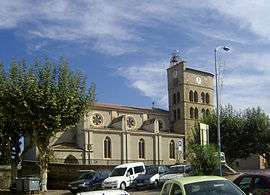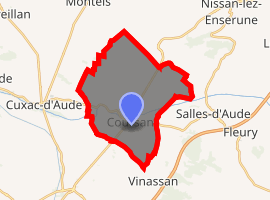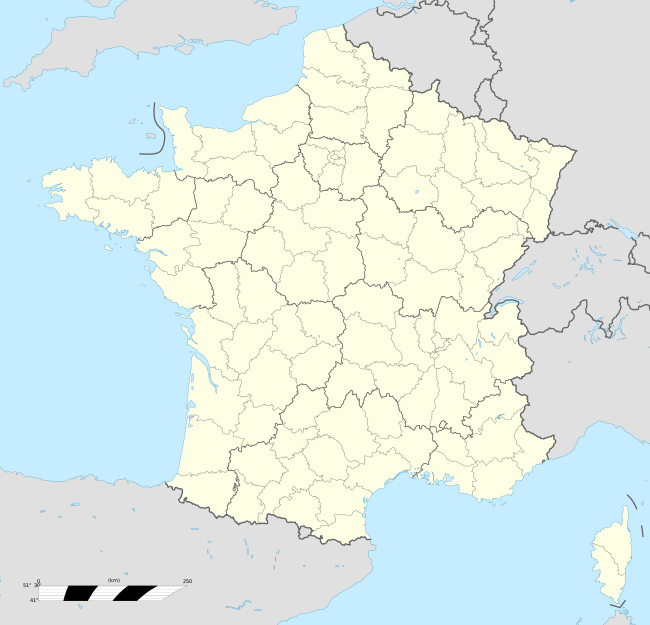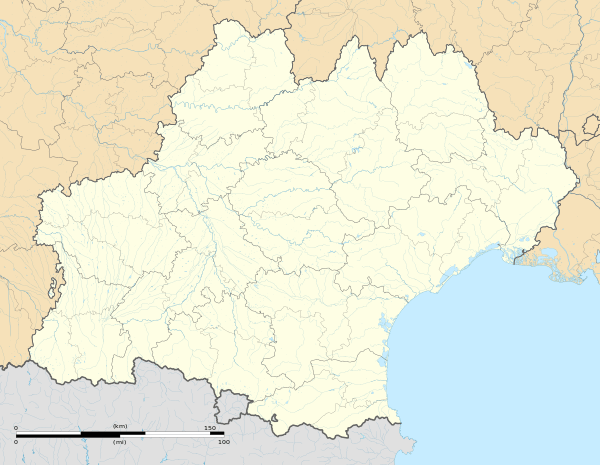Coursan
Coursan is a commune in the Aude department in southern France.
Coursan | |
|---|---|
 The church in Coursan | |
.svg.png) Coat of arms | |
Location of Coursan 
| |
 Coursan  Coursan | |
| Coordinates: 43°13′57″N 3°03′32″E | |
| Country | France |
| Region | Occitanie |
| Department | Aude |
| Arrondissement | Narbonne |
| Canton | Les Basses Plaines de l'Aude |
| Intercommunality | Narbonnaise |
| Government | |
| • Mayor (2008–2014) | Gilbert Pla (PCF) |
| Area 1 | 24.61 km2 (9.50 sq mi) |
| Population (2017-01-01)[1] | 5,908 |
| • Density | 240/km2 (620/sq mi) |
| Time zone | UTC+01:00 (CET) |
| • Summer (DST) | UTC+02:00 (CEST) |
| INSEE/Postal code | 11106 /11110 |
| Elevation | 0–14 m (0–46 ft) |
| 1 French Land Register data, which excludes lakes, ponds, glaciers > 1 km2 (0.386 sq mi or 247 acres) and river estuaries. | |
It is 7 km from Narbonne on the Aude. There is a bridge built in the fifteenth century, over which passes the RN9 road. The town has a church from the same period which is in the course of being restored.
Composer Henry Fourès was born in Coursan (17 May 1948)
Population
| Year | Pop. | ±% |
|---|---|---|
| 1793 | 1,440 | — |
| 1800 | 1,436 | −0.3% |
| 1806 | 1,414 | −1.5% |
| 1821 | 1,630 | +15.3% |
| 1831 | 1,761 | +8.0% |
| 1836 | 1,850 | +5.1% |
| 1841 | 2,022 | +9.3% |
| 1846 | 2,040 | +0.9% |
| 1851 | 2,172 | +6.5% |
| 1856 | 2,231 | +2.7% |
| 1861 | 2,154 | −3.5% |
| 1866 | 2,447 | +13.6% |
| 1872 | 2,538 | +3.7% |
| 1876 | 2,709 | +6.7% |
| 1881 | 3,458 | +27.6% |
| 1886 | 3,786 | +9.5% |
| 1891 | 3,847 | +1.6% |
| 1896 | 3,767 | −2.1% |
| 1901 | 3,829 | +1.6% |
| 1906 | 3,802 | −0.7% |
| 1911 | 3,793 | −0.2% |
| 1921 | 4,121 | +8.6% |
| 1926 | 4,273 | +3.7% |
| 1931 | 4,438 | +3.9% |
| 1936 | 3,589 | −19.1% |
| 1946 | 3,271 | −8.9% |
| 1954 | 3,228 | −1.3% |
| 1962 | 3,212 | −0.5% |
| 1968 | 3,366 | +4.8% |
| 1975 | 3,334 | −1.0% |
| 1982 | 4,021 | +20.6% |
| 1990 | 5,137 | +27.8% |
| 1999 | 5,241 | +2.0% |
| 2008 | 6,124 | +16.8% |
gollark: I just want to look at how my updated Rednet_notes looks.
gollark: How do you preview a template?
gollark: Will do.
gollark: Sorry, rednet.open.
gollark: You need to modem.open too.
This article is issued from Wikipedia. The text is licensed under Creative Commons - Attribution - Sharealike. Additional terms may apply for the media files.